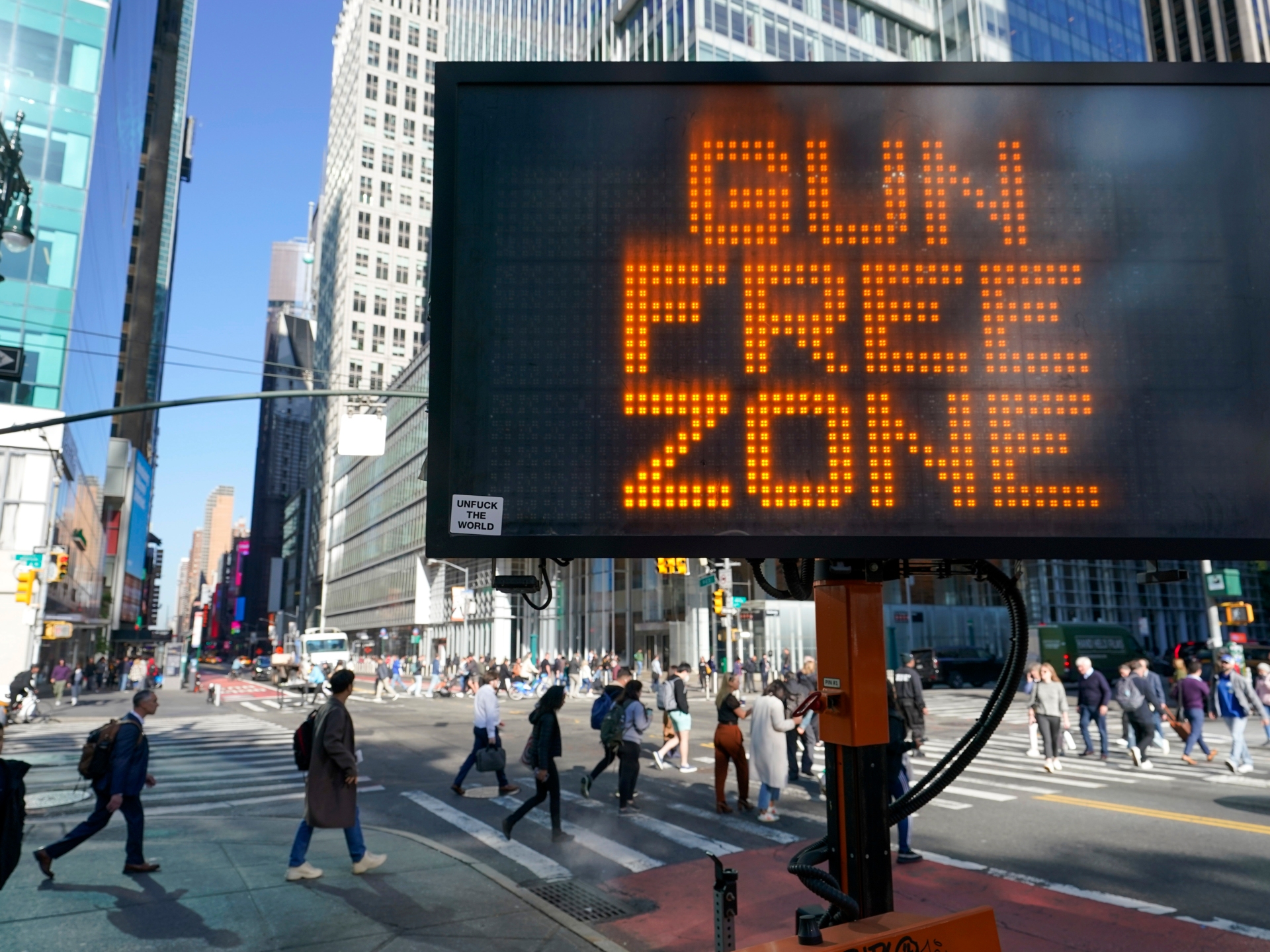It was the 199th mass shooting of the year so far in the United States: On Saturday, a gunman in Allen, Texas, opened fire at an outdoor shopping mall, killing eight people, three of whom were children.
But even as the bloodshed has prompted another push to increase restrictions on guns, a concurrent series of court battles have been wrestling with the question of where the constitutional right to “bear arms” ends — and where the government’s right to impose controls begins.
That debate has been kicked into overdrive following a Supreme Court decision last June that limited legislators’ ability to restrict firearm possession in public, offering a broad interpretation of the Second Amendment of the Constitution, the basis for gun rights in the US.
The ruling has led to an “explosion in court challenges”, said Nick Suplina, a senior vice president of law and policy at Everytown for Gun Safety, a nonprofit that supports stricter gun laws.
Suplina explained that the June decision “has really emboldened the farthest fringes of the [pro-gun] movement to say that everything that you could possibly think of in the realm of gun safety is unconstitutional”.
How those court battles play out could shape the landscape of gun control for generations and eventually determine state and federal legislators’ ability to enact lasting gun laws, advocates like Suplina told Al Jazeera.
“This moment is really important because expansive, unprecedented readings of the Second Amendment could lead to challenges of life-saving gun laws,” he said.
The current era of legal flux began with June’s ruling in New York State Rifle & Pistol Association v Bruen, which was based on 2008’s District of Columbia v Heller. That precedent determined a citizen’s right to bear arms is not connected to service in a militia — two concepts linked in the Second Amendment.
The Bruen case directly challenged a New York law that required gun owners to prove they had a special need to carry a firearm in public. The ruling deemed the New York law unconstitutional, saying the constitutional right to carry a gun extends beyond the home.
Conservative Supreme Court Justice Clarence Thomas wrote the majority opinion, which called for any new gun restrictions to pass two tests. First, the weapon in question must fall under the auspices of the Second Amendment. Second, the government must justify any restrictions on the right to bear arms “by demonstrating that it is consistent with the nation’s historical tradition of firearm regulation”.
That second item has proven to be particularly disruptive to gun control measures.
Thomas defined “historical tradition” as being rooted in measures that were in place when the Second Amendment was ratified in 1791, or even when the 14th Amendment was ratified in 1868. That amendment decrees that state laws cannot override federal laws.
While modern-day gun restrictions do not need an exact historical “twin”, they must be proven analogous to a past restriction, Thomas wrote, although he did not clearly state from which time period that analogy must be found.
Nevertheless, the ruling has sent lawyers sifting through centuries-old US and English law to find comparable measures that restricted weaponry.
In some cases, gun-control advocates have pointed to bans on billy clubs or other atypical weapons. In other cases, they have been forced to refer to racist laws that show the US had withheld gun ownership in the past from groups deemed dangerous, including free Black people, Indigenous groups and Catholics.
The problem is that “we’re not even talking about historical regulations from a century ago”, said Eric Ruben, an assistant professor at Southern Methodist University’s Dedman School of Law.
“Those are too recent. The Supreme Court said the historical regulations that now have to be put forward in order to justify the constitutionality of a modern gun law have to date from the late 1700s or maybe the 1800s,” he told Al Jazeera.
“The government and litigants and courts are struggling with how to analogise those historical regulations from a very different time with very different problems and very different technology to the modern day.”
‘Unfortunate and terribly dangerous’
In the eight months immediately after the ruling, an analysis by Jacob Charles, an associate professor at Pepperdine Caruso School of Law, found there had been 212 claims adjudicated in courts across the US challenging pre-existing gun restrictions based on Bruen.
In at least 31 of the claims, the courts ruled in favour of the challenger. Those cases include successful claims against requirements for licences to carry guns, assault weapon bans, and bans on so-called untraceable “ghost guns”, the report showed.
Most recently, pro-gun groups cited the Bruen ruling in an emergency appeal to the Supreme Court, seeking to block Illinois’s recently passed ban on assault-style firearms and large-capacity magazines. They argued there is “no historical analogue to such a ban”. A lower court, however, previously ruled the ban fits within “the history of firearm regulation”.
If the conservative-dominated Supreme Court does take the case, its ruling could have wide-ranging implications for the future of such bans.
Meanwhile, particular controversy surrounded a February ruling from the Fifth Circuit District Court which struck down a federal law that prevented individuals accused of domestic abuse who are subject to protective orders from possessing a gun.
The administration of President Joe Biden has petitioned the Supreme Court to take on the case, which contradicts several other rulings, although the top justices have yet to announce if they will do so.
But the prevailing ambiguity leaves domestic abuse survivors at risk, according to Marium Durrani, vice president of policy at the National Domestic Violence Hotline.
For instance, in Mississippi, she noted that, even in domestic violence cases where a protective order has been granted, the “person who harmed you no longer has to turn in their firearm. It’s no longer unlawful for them to possess their firearm”.
“What’s really unfortunate and terribly dangerous is that when survivors leave their abusive relationship or make moves to leave abusive relationship in order to protect themselves, that’s the most dangerous time and one of the highest times for homicide,” Durrani explained.
Data from the hotline showed a 56.6 percent uptick in calls mentioning firearms in the states covered by the Fifth Circuit court — Mississippi, Louisiana and Texas — between February 2 and March 9, compared with the same time period last year.
“While we recognise correlation is not causation, these numbers are certainly suggestive and frankly alarming,” Durrani said.
Domestic abuse has also been shown to play a disproportionate role in mass shootings. One 2021 study found that nearly 60 percent of shootings with four or more victim fatalities between 2014 and 2019 were related to domestic violence.
‘Downstream consequences’
Judicial discord has reigned since the Supreme Court’s Bruen ruling, said Ruben, the law professor at Southern Methodist University.
As with the domestic violence restriction, other gun control measures have been subject to conflicting rulings from federal courts across the country, Ruben explained. They include age limits for gun carry, a ban that would prevent people under federal indictment from acquiring a gun, restrictions on high-capacity magazines and a measure that would prohibit possession of firearms with altered serial numbers.
Ruben said further clarity is needed from the Supreme Court for the full implications of the Bruen ruling to be made clear. But in the meantime, he warned of potential “downstream consequences”. Legislators, for instance, may be discouraged from pursuing restrictions they fear will be quickly struck down.
For his part, Everytown’s Suplina said that legislators have largely not been “chilled into inaction” and continue to move forward with ambitious reforms in many states. He added that he believes many gun restrictions will stand after the Bruen ruling.
“We are confident the Supreme Court did not intend to give a limitless interpretation of the Second Amendment in the Bruen case. We hope it takes the opportunity to make that clear to lower court judges across the country,” he said.
Doug Letter, chief legal officer at the gun control advocacy group Brady, also said he was optimistic about the prospect of proving that gun regulations are part of an historical US tradition.
In an email, he said “the present moment is an opportunity for governments to pass constitutional, life-saving gun laws that are consistent with the Supreme Court’s decisions in Heller and Bruen.”
“It is imperative that governments do so. Many lives depend on it.”
Sumber: www.aljazeera.com
 Skip to content
Skip to content


